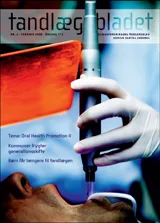Förebyggande vård främjar äldres munhälsa. Finland vill flytta focus från reparativ vård til profylax
Världshälsoorganisationen har nyligen uppmärksam- mat de äldres munhälsproblem samt sambandet mel- lan munhälsa och allmänhälsan. Stora utmaningar väntar för samhället: När befolkningen blir äldre och hälsoproblemen ändrar karaktär räcker inte gamla lösningar. Arbetet måste fokuseras på att kartlägga riskgrupper för de vanligaste munsjukdomarna karies och parodontit, samt att förebygga, hejda och be- härska dem. I dag satsas inte tillräckliga resurser på förebyggande vård utan vården koncentreras på repa- rativ behandling. I den här artikeln vill vi ge läsaren en ny syn på rutinerna för äldretandvård.
Oral Health Promotion among the Elderly in Finland: In 2005 the elderly (aged 65 and older) comprised 15% of the Finnish population, but by 2040 their proportion will increase to 27%. The fastest growing group is those aged 75 and older, which by 2040 will more than double. The vast majority of all elderly are able to live independently at home; 8% live in institutions and 10% receive some home help. Based on recent nation-wide data, 44% of the elderly were edentulous and 22% had 20 or more teeth. Women and those elderly with the lowest levels of education or income had the lowest numbers of teeth. Of the elderly in Finland, 71% wore removable dentures; of those with 1 to 19 teeth, 23% had no denture. Among the dentate elderly, one of three had untreated caries (DT>0), whereas two of three had deepened (4+ mm) periodontal pockets and dental plaque, all of these findings being most common for men. Of the denture-wearers, 71% of the women and 50% of the men reported cleaning their dentures twice daily. Half of the dentate elderly reported twice-daily tooth brushing, but two of three did not clean interdental spaces. With regard to their most recent dental treatment, 6% reported having received instructions on tooth brushing, 1% on diet, and 1% on home use of fluorides. Oral health promotion in the elderly will be a demanding challenge, since the numbers of dentate elderly in Finland will double within the next 35 years. To improve their oral health and the level of oral self-care and oral cleanliness, we suggest activities by and cooperation between administration, communities, the dental profession, and other health care workers. Networks should be created to reach those elderly who are at risk of being overlooked by the system that delivers oral health care. In addition, the public sector of the oral health services should employ more dental hygienists. To control caries and periodontal disease, the dental profession should, instead of merely filling cavities, emphasize prevention. The dental curriculum should also include longer courses in geriatric dentistry. Furthermore, the growing need for dental hygienists requires that more hygienists be educated.


